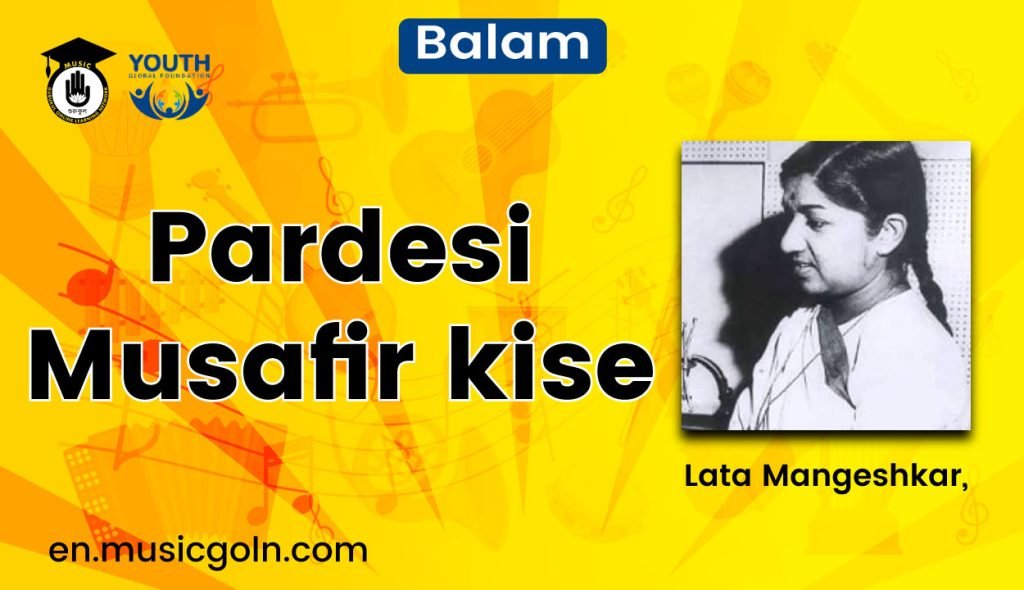Pardesi musafir kise lyrics | Lata Mangeshkar | Balam | 1949
Song Name : Paradesi Musaafir Kise
Movie : Balam
Singer : Lata Mangeshkar, Suraiya Jamaal Sheikh (Suraiya)
Music Director : Bhagatram Batish, Husnlal Batish
Lyrics by : Qamar Jalalabadi
Balam is a 1949 Hindi romantic action film directed by Homi Wadia.[1] Credited as A Hila Wadia Production by Wadia Brothers the film starred Suraiya, Wasti, Masood, Nigar Sultana, Jayant, Gulnar and Agha.The music directors were Husnlal Bhagatram.
Pardesi musafir kise lyrics | Lata Mangeshkar | Balam | 1949
Pardesi musafir kise lyrics :
Oo paradesi musaafir
Oo paradesi musaafir
Kise karataa hai ishaare
Kise karataa hai ishaare
Itna to bataa de
Itna to bataa de
Teraa dil kis ko pukaare
Kis ko pukaare
Oo paradesi musaafir
Lutaa hai mujhe tune hi
Mehamaan bana ke
Mujhe mehamaan bana ke
Lutaa hai mujhe tune hi
Mehamaan bana ke
Mujhe mehamaan bana ke
Oo puchhanewaale
Oo puchhanewaale
Meraa dil tujhako pukaare
Tujhako pukaare
Oo paradesi musaafir
Oo paradesi musaafir
Aa gaaen fizaao me
Mohabbat ke taraane
Mohabbat ke taraane
Aa gaaen fizaao me
Mohabbat ke taraane
Mohabbat ke taraane
Aa kar na chale jaaen
Saawan ke nazaare
Saawan ke nazaare
Oo paradesi musaafir
Oo paradesi musaafir
Darataa hoon mohabbat meri
Ho jaae na badanaam
Ho jaae na badanaam
Darataa hoon mohabbat meri
Ho jaae na badanaam
Ho jaae na badanaam
Oo dekhe naa zamana
Oo dekhe naa zamana
Kahi aankho ke ishaare
Aankho ke ishaare
Oa paradesi musaafir
Kise karataa hai ishaare
Itna to bataa de
Teraa dil kis ko pukaare
Kis ko pukaare
Oa paradesi musaafir.
Lata Mangeshkar (born as Hema Mangeshkar; 28 September 1929 – 6 February 2022) was an Indian playback singer and occasional music composer. She is widely considered to have been one of the greatest and most influential singers in India.Her contribution to the Indian music industry in a career spanning eight decades gained her honorific titles such as the “Queen of Melody”, “Nightingale of India”, and “Voice of the Millennium”.
Lata recorded songs in over thirty-six Indian languages and a few foreign languages, though primarily in Marathi, Hindi, and Bengali.Her foreign languages included English, Russian, Dutch, Nepali, and Swahili.
She received several accolades and honors throughout her career. In 1989, the Dadasaheb Phalke Award was bestowed on her by the Government of India.In 2001, in recognition of her contributions to the nation, she was awarded the Bharat Ratna, India’s highest civilian honour; she is only the second female singer, after M. S. Subbulakshmi, to receive this honour.France conferred on her its highest civilian award, Officer of the National Order of the Legion of Honour, in 2007.
She was the recipient of three National Film Awards, 15 Bengal Film Journalists’ Association Awards, four Filmfare Best Female Playback Awards, two Filmfare Special Awards, the Filmfare Lifetime Achievement Award and many more. In 1974, she was one of the first Indian playback singers to perform at the Royal Albert Hall in London, UK. Her last recorded song was “Saugandh Mujhe Is Mitti ki” released on 30 March 2019 as a tribute to the Indian Army and the Nation.
In the same year, she established the Master Deenanath Mangeshkar Hospital in Pune, managed by the Medical Foundation (founded by the Mangeshkar family in October 1989). In 2005, she designed a jewellery collection called Swaranjali, which was crafted by Adora, an Indian diamond export company. Five pieces from the collection raised £105,000 at a Christie’s auction, and a part of the money was donated for the 2005 Kashmir earthquake relief. Also in 2001, she recorded her first Hindi song with the composer Ilaiyaraaja, for the film Lajja;
she had earlier recorded Tamil and Telugu songs composed by Ilaiyaraaja.
Her song “Wada Na Tod” was included in the film Eternal Sunshine of the Spotless Mind (2004) and in its soundtrack.
lthough she had limited coloratura skills in her early career, she developed better tone and pitch as she progressed in her playback career. Lyrics of songs in Hindi movies were, in those days, primarily composed by Urdu poets and contained a higher proportion of Urdu words, including the dialogue.
Actor Dilip Kumar once made a mildly disapproving remark about her accent while singing Hindi/Urdu songs; so for a period of time, she took lessons in Urdu from an Urdu teacher named Shafi.In subsequent interviews she said that Noor Jehan heard her as a child and had told her to practice a lot. The two stayed in touch with each other for many years to come
In 2001, Mangeshkar was awarded the Bharat Ratna, India’s highest civilian honour.
At one point, she appeared in the Guinness World Records, which listed her as the most recorded artist in history between 1948 and 1987
In the 1950s, Mangeshkar sang songs composed by various music directors of the period, including Anil Biswas (in films such as Tarana (1951) and Heer (1956)
Read more:
- Hawa men udta jae mera lal dupatta lyrics | Lata Mangeshkar | Barsaat |1949
- Barsaat men humse mile lyrics | Lata Mangeshkar | Barsaat | 1949
- Man men teri yaad basi lyrics | Lata Mangeshkar | Bhedi Bungla | 1949
- Yun to apas men lyrics | Lata Mangeshkar, Mohammed Rafi | Andaz | 1949
- Meri ladli re lyrics | Chorus, Lata Mangeshkar | Andaz | 1949
